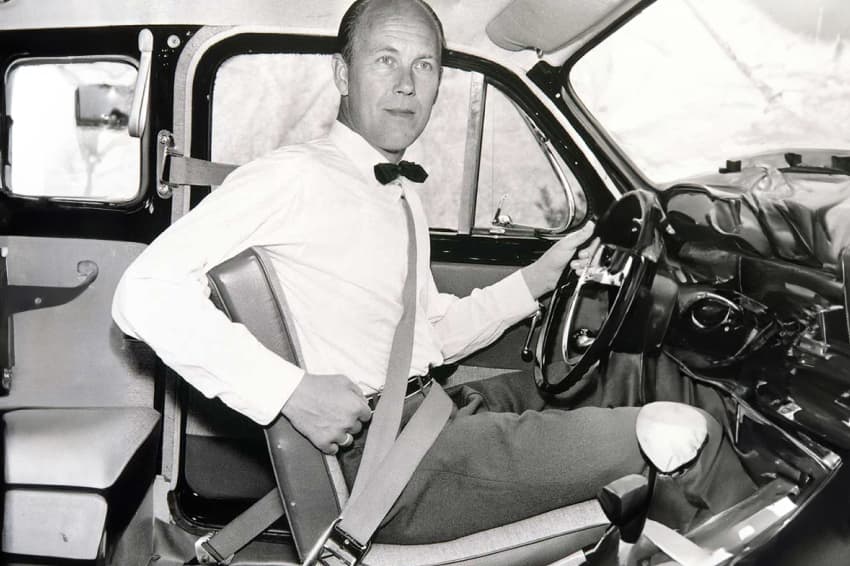
FREE Postage via Royal Mail | 10% OFF On Orders Over £20

Seat belts have become such an ordinary part of driving that most of us never stop to wonder where they came from.
Yet, behind every simple buckle is a story of innovation, debate, and a battle for public health. Let’s pull back the curtain on the invention of the seat belt, and see how it changed vehicle safety forever.
Quick Answer: The modern seat belt was invented by Nils Bohlin, a Swedish engineer at Volvo, in 1959. His “three-point seat belt” design, which secures both the upper and lower body with a single diagonal belt across the chest and lap, became the global standard for automotive safety.
Before 1959, seat belts were simple lap belts. Bohlin’s invention saved more than one million lives and remains the single most important safety feature in every vehicle on the road.
Before the three-point seat belt, early inventors were already thinking about how to keep people safe in a collision. The history of seat belts actually stretches back to the 1800s.
In 1849, English engineer Sir George Cayley, widely known for his work in aviation, created the first safety harness for his early flying machines. His invention was a simple belt, designed to keep the occupant secure during turbulent flights.
By the 1930s, seat belts were appearing in cars and airplanes, but they were basic two-point waist restraints, what we now call the lap belt.
In the 1940s, Nash Motors became the first car company to offer seat belts as an optional feature. Yet, most people believed it was safer to be thrown clear in a car crash than restrained by a belt.
Early seat belts were simple and often met with scepticism. Only a visionary could turn these early designs into something that would become essential for passenger safety.

The real breakthrough came in 1959 when Volvo hired Nils Bohlin, an aviation engineer who had previously worked on ejector seats. Drawing on his experience in aviation safety, Bohlin realised that a belt across both the chest and lap would secure the entire body during impact.
He designed the modern three-point seat belt, which uses a single continuous strap to restrain both the upper and lower body. This design not only kept occupants secure but also made it easy to buckle and release.
Volvo quickly recognised the potential of Bohlin’s safety belt. The first car to feature the three-point seat belt as standard was the Volvo PV544 in 1959.
Bohlin’s seat belt patent was visionary and in line with Volvo’s guiding principle of safety. The three-point seat belt became a key part of automotive history.
Here’s a fact that never fails to impress me: Volvo gave away the three-point seat belt patent, allowing all car companies to use Bohlin’s design for free, in the interest of public health and saving lives. This decision to release the three-point belt design to other manufacturers was truly visionary and in line with Volvo’s guiding principle of safety.
By giving away the patent, Volvo saved more than one million lives and set a new standard for automotive safety.
The introduction of the three-point seat belt marked a turning point for automotive safety. Its design distributed force across the chest, pelvis, and shoulders, reducing the risk of fatality and serious injury in a car crash.
Over the past 60 years, the three-point seat belt has become the most important safety feature in every vehicle. Retractable seat belts, which make it easier for drivers and passengers to use seat belts comfortably, followed soon after.
Seat belts became mandatory in many countries, including the UK, once seat belt legislation and seat belt laws were introduced. These laws required drivers and passengers to use seat belts, leading to a dramatic drop in road accident fatalities.
The three-point seat belt has saved more than one million lives since its invention. Studies show seat belts reduce the risk of death for front-seat occupants by up to 50%.
The World Health Organisation and road safety experts agree: seat belts save lives. They are the single most effective restraint system in a vehicle.
Every time you buckle your seatbelt, you take an easy step that could save your life.
Nils Bohlin’s work left a mark on both automotive safety and public health. He received a gold medal from the Royal Swedish Academy of Engineering Sciences and was inducted into the Automotive Hall of Fame.
His invention of the three-point seat belt is rightly considered one of the greatest contributions to traffic and motor vehicle safety.
Today, every vehicle must have three-point seat belts for all occupants, thanks to national traffic and motor vehicle safety standards. The first seat belt law in the UK, passed in 1983, required drivers and front passengers to use seat belts. Later, laws expanded to include rear passengers.
Modern seat belts include advanced features like pretensioners and retractable seat belts, but Bohlin’s original three-point design remains at the heart of automotive safety.
Using a seat belt will always be the simplest, most effective way to protect yourself in a car.
The three-point seat belt, invented by Nils Bohlin at Volvo in 1959, transformed automotive safety and saved more than one million lives. The seat belt patent was visionary, and Volvo’s decision to release the three-point seat belt design set a standard for the entire automotive industry.
Next time you buckle up, remember: you’re part of a history of innovation, sacrifice, and a relentless drive to make every journey safer.
